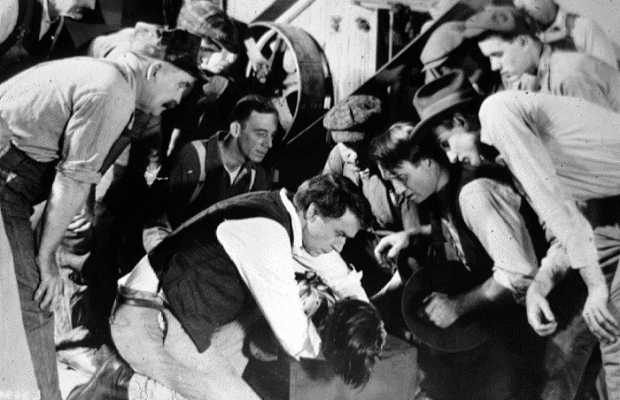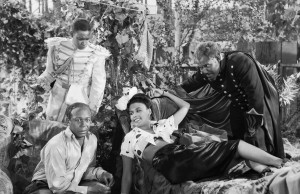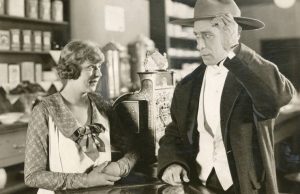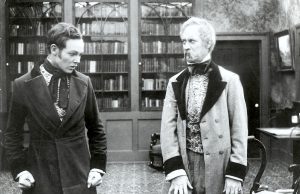The Whistle (1921)

For the first time in more than a year the Rialto exhibits the current week a William S. Hart special, the newest (Paramount) release by that hero of a hundred or more motion pictures with a background of western life. In “The Whistle,” however, there is an absolute digression from the western locale. Instead, it has a theme involving the conflict, labor versus capital.
The title of the picture retains the original from the story by May Wilmoth and Olin Lyman. The whistle is symbolic of the clarion that arouses from slumber a myriad army of workers to renew their activity in one of a thousand mills where the call is for pressure and an apparent absence of humaneness under the pressure.
As this whistle affects Robert Evans (William S. Hart) he is introduced as the father of a motherless lad. The spokesman for less intrepid employees, he appeals to Henry Chapple (Frank Brownlee) to adjust some faulty machinery which might cost some one’s life. The answer is a denial plus an argument that “they are late on orders.” Adjusting machinery would take too much time. The lad is subsequently caught in the whirl of faulty machinery and dies, a bleeding picture of helplessness born in the memory of his father. So deprived, his vendetta is born. He saves the mill owner’s boy from drowning, kidnaps him and subsequently brings him up as his sister’s son.
The action passes on to a construction camp several years later. Here circumstances again brings the boy together with his real parents while his self-imposed uncle is recovering from a bullet wound. There is a bit of tense acting between Evans and Mrs. Chapple (Myrtle Steadman), the boy’s mother, to whom thus far his parentage is unknown. A desire to acknowledge the legitimacy of the boy to the unhappy mother is frustrated by the relentless father, who is far from the humanitarian Evans deems fit for the bringing up of the lad.
The concluding episodes deal with the acknowledgment of Chapple to Evans that he was mistaken, his pledge that he will adopt the boy and brings him up to serve humanity. The confession follows, as well as the restoration of the boy to his rightful parents.
The picture as a whole falls short of the standard Hart has thus far created through individual acting and the numerous assets which he has become master of through the mediums enlisting him in the exposition of plainsmen’s “ethics.” By comparison with those he scarcely has an opportunity to “register” with that forcefulness that one is accustomed to in the work of this star.
With one exception there is an absence of violent action. There is an interpolated hundred or more feet depicting a fight, which for vigor and activeness is admirably effective. But its relation to the story is questionable, and whether the authors intended it or not the entire “shot” is incident, and therefore mechanically contrived.
In adapting the story Lambert Hillyer (also the director) did not possibly figure that the theme itself would be negative. Perhaps it never occurred to him that there are labor inspectors all over the United States keeping in close touch with every kind of a mill or factory. Rottenness in plant construction is something that the employer is quite anxious to adjust speedily because the government demands it. If the action of this story was coupled with the late 90’s or the early 1900’s it might be relevant.
The action of the first two reels combines the story’s more salient points. Its opening scenes are well done, but the pace is never kept up as in the picturization of Hart and the scrapping lad. Hart’s biggest scene is a debate with the mill owner, an attempt enacting certain scenes that might go very well on the spoken stage. Here they are lacking in screen effectiveness. The best acting is done by Miss Steadman as the bereaved mother. The role is outstanding for its sincerity, but it is hard to condone her extreme make-up. Mr. Brownlee is never suggestive of the callous mill owner, neither in attire nor personal features. The player was miscast. The three children act commendably.
As a production it is all that is should be in interiors and exteriors.
VARIETY, Step., February 25, 1950
A curious forerunner of a Fox melodrama of the 30’s, “Nancy Steele is Missing”, “The Whistle” was made when William S. Hart’s tremendous popularity as a western star was rapidly losing ground to the slicker, more actionful films of Tom Mix. However, Hart had always made the occasional non-western, and this film was in no way an attempt to change his basic screen image. Indeed, his standard Western hero is virtually transplanted into a contemporary story and setting. Hart was a thoroughly dedicated film-maker, but he was a good showman too: he includes just enough physical action to keep his Western admirers happy, enough sentiment to keep the ladies happy, and since a key element of the story is the death of a child, he kills him off early enough so that there has been no time for children in the audience to identify with him and thus be upset by his demise. It’s a slow but powerful little film, typical of the rugged story-lines and emotional intensity that Hart and his team (director Hillyer and cameraman August worked with him regularly, August later becoming a John Ford regular too on such films as “They Were Expendable”) packed into all their films.
WILLIAM K. EVERSON, March 1, 1974











Leave a Reply